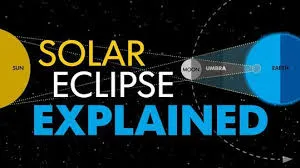REVERENT men have often marveled at the intelligent planning of the solar system. The Creator placed the earth at just the right distance from the sun to receive the proper light and heat to make life possible. Also, the moon’s distance is nicely balanced to perform its services to the earth—not too far to give adequate light at night, nor so close that the tides reach disastrous heights.

Source: googleimage
But did you know that this adjustment of distance that allows for ideal living conditions on earth also is crucial for making possible the beauty of the total eclipse of the sun?
In diameter the sun is actually 400 times as large as the moon, but its distance from the earth is also 400 times as much as that of the moon. If the moon were appreciably nearer it would blot out the sun’s chromosphere and much of the corona. If it were only a little farther away, it would be too small to cover the sun and we could never see a total eclipse.
Is it just a coincidence that the Creator, who gave the earth a beautifully transparent atmosphere so that its intelligent inhabitants could see and study the universe; who also provided an unending variety of cloud formations to play with sunlight and produce sunsets of gorgeous beauty; who paints the sky so delightfully with the wondrous rainbow—that he also set the moon in such an orbit that it would give man a rare glimpse of the glory of the eclipsed sun?

Source: googleimage
Consider further that the endowment of this spectacle is a gift unique to the earth. It does not occur on other planets, which are not inhabitable. The two moons of Mars are so tiny that they would not cover the sun as viewed from Mars. Jupiter has larger moons, but they are so close that they would appear much larger than the sun to someone on the surface of that planet. But even on earth the spectacle of the total eclipse is far from common.
When the total eclipse of the sun took place this past March, even many of the spectators may not have fully appreciated what a really rare experience it is.
On consulting an almanac, we learn that a total eclipse actually occurs in most years somewhere on earth. There have been forty-nine in this century. But this “somewhere” is most likely to be out over the oceans, which cover 71 percent of the earth’s surface. Then, too, half of the land area is uninhabited desert, jungle, tundra or ice field. Few of the eclipses are visible in populated areas. If you stay where you are, you can expect to see a total eclipse only once in 360 years—and then it will, likely as not, be cloudy. Nine persons out of ten would live and die without ever enjoying this experience. On the other hand, if you can travel a few hundred miles at the right time, you will probably have an opportunity at least once in your lifetime to see a total eclipse.
Why should such a magnificent exhibition be visible each time to so few? Because the moon’s shadow is very small where it strikes the earth. It would be larger if the moon were larger or closer, but that, as we have seen, would spoil the show. So the moon’s shadow must be only 100 miles or so across, and traveling as it does at more than 1,000 miles per hour, it can cover one spot for only a few minutes. Appreciating this, we marvel at the Creator’s wisdom shown in his design of this wonder.
Really, we should feel perhaps dissatisfied, not with the rarity of the eclipse, but with the shortness of life. True, the One who designed the total eclipse made it to be seen only three times in a millennium. But then, as the Bible shows, He designed the spectator to live forever.
Thank you for your time and attention! Take care. Peace..